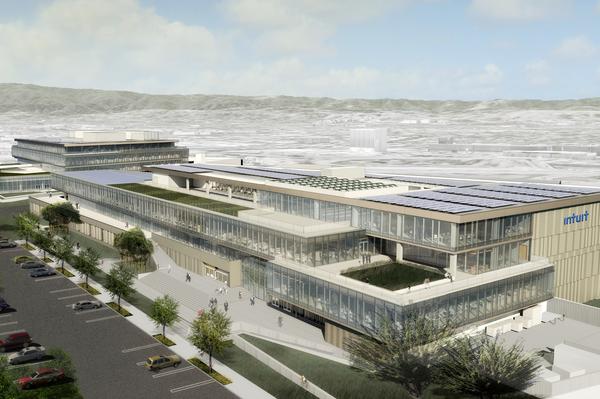Demolition will begin this week as a precursor to construction of Intuit's new addition to its Mountain View, Calif., campus. The first of two additions, a 185,000-sf building on Marine Way, is expected to begin construction in August.
According to the Silicon Valley Business Journal, Intuit already occupies approximately a million sf in Mountain View and Menlo Park. The second addition, located at Bayshore Parkway and Garcia Avenue, is set to reach LEED Platinum standards and house up to 900 employees.
Designed by WRNS Studio and Clive Wilkinson Architects, the Bayshore building will feature floor-to-ceiling glass, green spaces on the roof, and will be surrounded by 74,000 sf of landscaped area.
Intuit's global head of real estate Chris Glenning spoke of the new Mountain View projects during a recent panel discussion, saying: "When I joined a couple of years ago, we were just figuring out our future. Our board decided we would stay in our campus, and we'd start making investments in upgrading our existing buildings and add some land around us."
On their existing campus, Intuit already has a special center for employee amenities, and there a plans to build a "main street" environment where the ground floors of Intuit buildings create a walkable interface.
"The idea is that talent is what it's all about," Glennon said. "We engaged our friends at WRNS and Clive Wilkinson to help us develop the next wave of our development."
Completion is set for 2016.
Related Stories
| Aug 11, 2010
Great Solutions: Healthcare
11. Operating Room-Integrated MRI will Help Neurosurgeons Get it Right the First Time A major limitation of traditional brain cancer surgery is the lack of scanning capability in the operating room. Neurosurgeons do their best to visually identify and remove the cancerous tissue, but only an MRI scan will confirm if the operation was a complete success or not.
| Aug 11, 2010
Great Solutions: Collaboration
9. HOK Takes Videoconferencing to A New Level with its Advanced Collaboration Rooms To help foster collaboration among its 2,212 employees while cutting travel time, expenses, and carbon emissions traveling between its 24 office locations, HOK is fitting out its major offices with prototype videoconferencing rooms that are like no other in the U.
| Aug 11, 2010
2009 Judging Panel
A Matthew H. Johnson, PE Associate Principal Simpson Gumpertz & HegerWaltham, Mass. B K. Nam Shiu, SE, PEVP Walker Restoration Consultants Elgin, Ill. C David P. Callan, PE, CEM, LEED APSVPEnvironmental Systems DesignChicago D Ken Osmun, PA, DBIA, LEED AP Group President, ConstructionWight & Company Darien, Ill.
| Aug 11, 2010
Inspiring Offices: Office Design That Drives Creativity
Office design has always been linked to productivity—how many workers can be reasonably squeezed into a given space—but why isn’t it more frequently linked to creativity? “In general, I don’t think enough people link the design of space to business outcome,” says Janice Linster, partner with the Minneapolis design firm Studio Hive.
| Aug 11, 2010
BIM school, green school: California's newest high-performance school
Nestled deep in the Napa Valley, the city of American Canyon is one of a number of new communities in Northern California that have experienced tremendous growth in the last five years. Located 42 miles northeast of San Francisco, American Canyon had a population of just over 9,000 in 2000; by 2008, that figure stood at 15,276, with 28% of the population under age 18.







